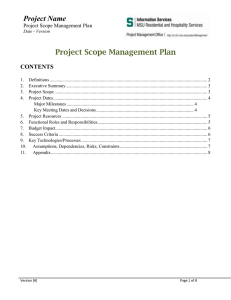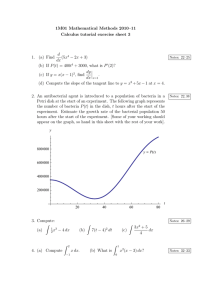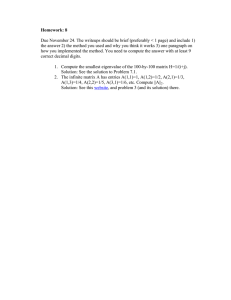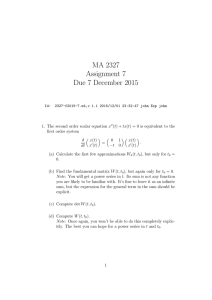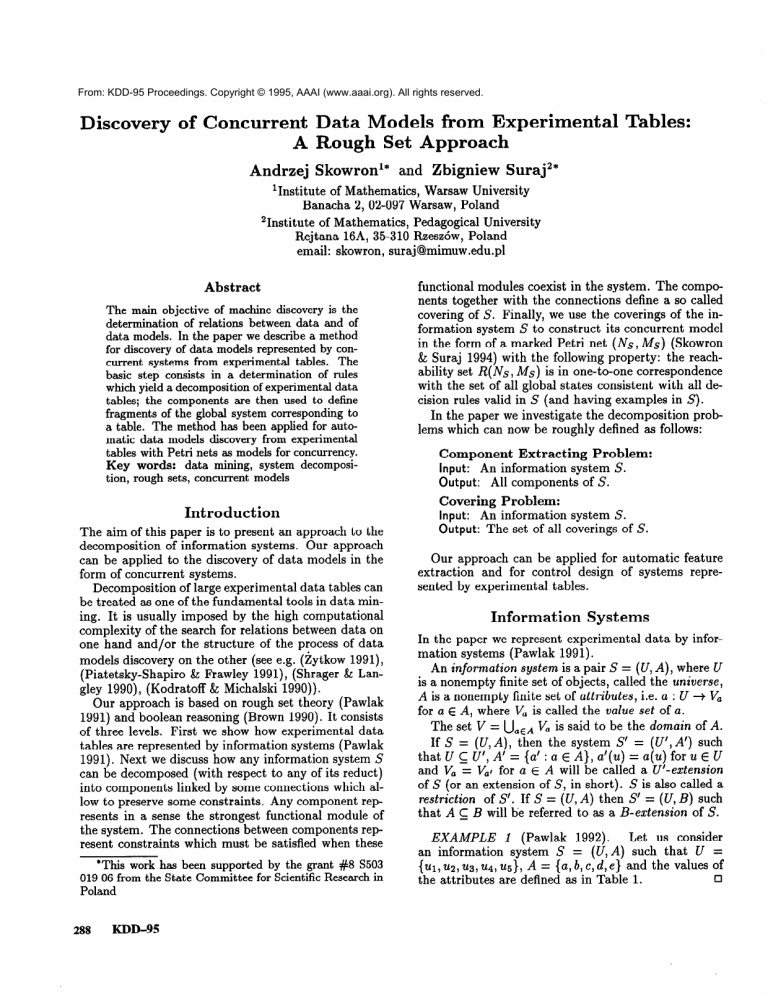
From: KDD-95 Proceedings. Copyright © 1995, AAAI (www.aaai.org). All rights reserved.
Discovery
of Concurrent
Data Models from Experimental
A Rough Set Approach
Andrzej
Skowronl*
and Zbigniew
Tables:
Suraj2*
‘Institute
of Mathematics,
Warsaw University
Banacha 2, 02-097 Warsaw, Poland
21nstitute of Mathematics,
Pedagogical
University
Rejtana 16A, 35-310 Rzeszbw, Poland
email: skowron, suraj@mimuw.edu.pl
Abstract
The main objective of machine discovery is the
determination
of relations between data and of
data models. In the paper we describe a method
for discovery of data models represented by concurrent systems from experimental
tables. The
basic step consists in a determination
of roles
which yield a decomposition of experimental data
tables; the components are then used to define
fragments of the global system corresponding to
a table. The method has been applied for automatic data models discovery from experimental
tables with Petri nets as models for concurrency.
Key words:
data mining, system decomposition, rough sets, concurrent models
functional modules coexist in the system. The components together with the connections define a so called
covering of S. Finally, we use the coverings of the information system S to construct its concurrent model
in the form of a marked Petri net (Ns, MS) (Skowron
& Suraj 1994) with the following property: the reachability set R(Ns, iVs) is in one-to-one correspondence
with the set of all global states consistent with all decision rules valid in S (and having examples in S) .
In the paper we investigate the decomposition problems which can now be roughly defined as follows:
Component
Extracting
Problem:
An information system S.
All components of S.
Covering Problem:
Input:
An information system S.
Output:
The set of all coverings of S.
Input:
Output:
Introduction
The aim of this paper is to present an approach to the
decomposition
of information
systems.
Our approach
can be applied to the discovery of data models in the
form of concurrent
systems.
Decomposition
of large experimental
data tables can
Our approach
can be applied
for automatic
feature
extraction and for control design of systems represented by experiment al tables.
be treated as one of the fundamental tools in data mining. It is usually imposed by the high computational
complexity of the search for relations between data on
one hand and/or the structure of the process of data
models discovery on the other (see e.g. (iytkow 1991),
(Piatetsky-Shapiro
& Frawley 1991), (Shrager & Langley 1990), (Kodratoff & Michalski 1990)).
Our approach is based on rough set theory (Pawlak
1991) and boolean reasoning (Brown 1990). It consists
of three levels. First we show how experimental data
tables are represented by information systems (Pawlak
1991). Next we discuss how any information system S
can be decomposed (with respect to any of its reduct)
into components linked by some connections which allow to preserve some constraints. Any component rep
resents in a sense the strongest functional module of
the system. The connections between components rep
resent constraints which must be satisfied when these
In the paper we represent experimental data by information systems (Pawlak 1991).
An information system is a pair S = (V, A), where U
is a nonempty
finite set of objects, called the universe,
A is a nonempty finite set of attributes, i.e. a : U + Va
for a E A, where Va is called the value set of a.
The set V = UaEA V, is said to be the domain of A.
If S = (U,A), then the system S’ = (U’, A’) such
that U C U’, A’ = {a’ : a E A}, u’(u) = a(u) for u E U
and Va = Val for a E A will be called a U/-extension
of S (or an extension of S, in short). S is also called a
restriction of S’. If S = (U, A) then S’ = (U, B) such
that A E B will be referred to a~ a B-extension of S.
*This work has been supported by the grant #8 S503
019 06 from the State Committee for Scientific Research in
Poland
the attributes
288
KDD-95
Information
EXAMPLE
an information
(~1,
~2, ~3, ~4,
Systems
1 (Pawlak
1992).
Let us consider
(U, A) such that U =
us), A = {a, b, c,d,e} and the values of
0
are defined as in Table 1.
system
S =
Table 1. An example of an information
system
LetS=(U,A)b
e an information system. With any
subset of attributes B C A we associate a binary relation ind( B), called indiscernibility relation, which is
defined by: ind(B) = {(u, u’) E U x U : for every a E
B, u(u) = a(~‘)}.
Any information system S = (U, A) determines an
information function,
InfA : U + P(A x V) defined by InfA (u) = {(a, u(u)) : a E A}, where
v = UaEA Va and P(X) denotes the powerset of X.
The set {In fA (u) : u E U} will be denoted by INF(S).
Hence, u ind(A)u’ iff InfA(u) = InfA(u’).
The values of an information function will be sometimes represented by vectors of the form (VI, . . . , urn)
with vi E Vai for i = 1,. . . , m, where m = IAI. Such
vectors are called information vectors (over V and A).
Let S = (U,A) b e an information system, where
A = {al, . . . . a,}. Pairs (a,~) with a E A, v E V are
called descriptors. Instead of (a, V) we also write a = v
or a,.
The set of terms over A and V is the least set
containing descriptors (over A and V) and closed
with respect to the classical propositional connectives:
1, V, A. The meaning 11r 11~ (or in short II r 11)of a
term r in S is defined inductively as follows:
11(a, v) II= {u E U : u(u) = v) for a E A and v E Va;
II T v 7’II=11r II IJ II 7’II;II r A 7’II=11
7-II fl II T’II;
II lT II= u- II r II *
Decision
Rules
Decision rules express some of the relationships between attributes of information systems.
Let S = (U,A) b e an information system and let
B,C E A. We say that the set C depends on B in
S in degree Ic(0 5 Ic 5 1) , symbolically B sTk C, if
k=v,
where POSB(C) is the B-positive
region of C in S (Pawlak 1991).
If k = 1 we write B 2 C instead of B zk C. In this
case B ‘;t C means that ind(B) C ind(C). If the right
hand side of a dependency con&ts of one attribute
only, we say the dependency is elementary.
A decision rule over A and V is any expression of the
following form: (1) Ui, = Vi, A. . .AUii = Vi, * UP = VP,
where UP, uij E A, up, vij E Vaij for 1 5 j 5 r.
A decision rule of the form (1) is called trivial if
UP = up also appears on the left hand side of the rule.
It is true in S if II ai, = vi1 A . . . A ai, = vi, 11~11ap =
up 11,which is denoted by (2) ai, = vi, A . . . A ai, =
Vi, z up = vp. A rule of type (2) has an example in
S if II ai, = vi, A . . . A ai, = vi,. lls# 8. By D(S)
we denote the set of all true decision rules which have
examples in S.
Let R C D(S). A n information vector v = (vl, . . .,
vm) is consistent with R iff for any decision rule ai, =
vi1 A . . . A Ui, = Vi, =P UP = vp in R if vii = vii for
j = 1, . . . , ‘P then up = vp. The set of all information
vectors consistent with R is denoted by CON(R).
Let S’ = (U’, A’) b e a U/-extension of S = (U, A).
We say that St is a consistent extension of S iff D(S) C
D(S’). S’ is a maximal consistent extension of S iff
S’ is a consistent extension of S and any consistent
extension S” of S is a restriction of S’.
Reduction
of Attributes
Let S = (U, A) be an information system. A subset
B C A is a reduct of S (Pawlak 1991) iff ind(B) =
ind(A) and ind(B’) # ind(A) for any B’ c B. The set
of all reducts in S is denoted by RED(S).
Let S = (U,A) b e an information system and let us
assume that U = {ui, . . . , un}, and A = (al, . . . , a,}.
By M(S) we denote an n x n matrix (cij), called the
discernibility matrix of S, such that cij = {u E A :
c$&)) # u(uj)} for i, j = 1, . . . , n (Skowron & Rauszer
With any discernibility matrix M(S) we can associate a discernibility function fM(q.
The discernibility function fM(q for an information
system S
is a boolean function of m propositional
variables
(where ai E A for i = l,...,m)
defined as
al,...dh
the conjunction of all expressions V cij, where V cij
is the disjunction of all the elements of cij = {a :
u E cij}, where 1 5 j < i 5 n and cij # 0. In the
sequel we write a instead of a when no confusion can
arise.
PROPOSITION
1 (Skowron & Rauszer 1992).
Lets=
(U,A) be an information system and let fM(s)
be a discernibility function for S. Then all prime implzcants (Wegner 1987) of the function fM(s) correspond
to all reducts of S.
In order to construct a concurrent model for a given
information system all reducts of the system have to
be computed first (Skowron & Rauszer 1992).
PROCEDURE
Step 1. Compute
system S.
for computing
the discernibility
RED(S):
matrix
Step 2. Compute the discernibility function
associated with the discernibility matrix M(S).
for the
fM(s)
Step 3. Compute the minimal disjunctive normal
form of the discernibility function fiM(~). (The normal
form of the function yields all reducts).
EXAMPLE ,% Applying the above procedure to the
system in Example 1, we obtain two reducts: RI =
0
{a, b, c} and R2 = {a, b, e} of the system.
Skowron
289
PROPOSITION
2 (Pawlak 1992). Let S = (U, A)
be an information system, R E RED(S), and R c A.
Let f~(s’) be a relative discernibility function for the
system S’ = (U, R U {a*}), where a* E A - R. Then
all prime implicants of the function fM(p) correspond
to all (a’) - reducts of S’.
The next example illustrates how to find all dependencies among attributes.
EXAMPLE
S. Let us consider again the system
S from Example 1. We have {a, b,c} 2 {d, e} and
W,4
2 {c,4,
so WV)
2 VII, WV)
2 kl,
{a, b, e) 2 (c}, {a, b,e} 2 {d). The set of rules corresponding to all nontrivial dependencies within the
reduct Ra has the form: al V a2 V bl 2 eo, a0 V a2 V
el V e2 s bo, el V e2 $J ao, bl s al, while the set
of decision rules corresponding to all nontrivial dependencies of R2 with c, d has the following form:
alVa2VblVeoVe2
s ~2, el s cl, alVa2VblVeo
s dl,
a0 V el V e2 2 d2. These rules can be generated by ap0
plying the method presented in (Skowron 1993).
Decomposition
of Information
Systems
This section introduces concepts and notation related
to the decomposition of information systems as well as
a method for constructing components and coverings of
a given information system with respect to its reducts.
Let S = (U,A) b e an information system. An information system S is said to be covered with constraints C (or C-covered, in short) by information systems 271 = (Ul,Al),
. . . , SI, = (Uk,Ak) if 1NF(S’) =
: InfA, (u1) u . . . u
{InfA,
(ul)
u . . . u InfA,(uk)
Inf&.(uk)
E CON(C) and ui E ui for i = 1,. . . , k},
where S’ is a maximal consistent extension of S and C
is a set of decision rules. The pair ({ S1, . . . , Sk } , C) is
called a C-covering of S (or a covering of S, in short).
Thesets Sl,..., Sk are its components and C is the set
of constraints (connections).
EXAMPLE
4. Let us consider the information system S from Example 1. It is easy to see that the information systems Si = (Ul , Al), S2 = (U2, A2) and
3 re P resented by Tables 2, 3 and 4, respec5’3=(U3,A)
tively, and the set of constraints C containing decision
rules al V a2 2 eo, el V e2 s ao, a0 V a2 2 bo, bl s al,
bl % ee, and el V e2 2 bo yield a C-covering of S.
290
Table 2. The information
system Si
Table 3. The information
system S2
KDD-95
Table 4. The information
system S’s
0
PROPOSITION
3. Every information system has
at least one covering.
If S = (U,A), then the system S = (U’, A’) such
that U’ 5 U, A’ = (a’ : a E B E A), a’(u) = a(u) for
u E U’ and V,’ = VQ for a E A is said to be a subsystem
of s.
EXAMPLE 5. Every information system in Example 4 is a subsystem of the system S from Example 1.
0
Let S = (U,A) b e an information system and let
R E RED(S). A n information system S’ = (U’, A’) is
a normal component of S (with respect to R) iff the
following conditions are satisfied: (i) S’ is a subsystem
of S, (ii) A’ = B U C, where B is a minimal (with
respect to C) subset of R such that B 2 {a} for some
a E A - R and C is the set of all attributes a with the
above property.
The set of all normal components of S (with respect
to R) is denoted by COMPR(S).
EXAMPLE 6. The subsystems S1, S2, S3 are normal components of S from Example 1 (with respect to
the reduct R2). A more detailed explanation of this
0
fact is included in Example 7.
PROPOSITION
4. Every information system has
at least one normal component (with respect to any of
its reduct).
Let S’ E COMPR(S)
and S’ = (U’, Bs’ U C’S)). By
XR we denote the set of all attributes which simultaneously occur in normal components of S (with respect to
R) and in the reduct R, i.e. XR = Us,ECOMPR(Sj Bs’.
Let XR be a set defined for S and R as above. We
say that a subsystem S’ = (U’, A’) of S is a degenerated
component of S (with respect to R) iff A’ = {a) for
some a E R-XR.
We denote this fact by {a) 2 8 (the
empty set).
In the sequel a component (with respect to a reduct)
will be assumed to be either a normal component or a
degenerated component (with respect to the reduct).
PROPOSITION
5. Let S = (U, A) be an information system and let R be its reduct. Then the information system S consists of IR - XR) degenerated
components (with respect to R).
Let S = (U, A) be an information system, R E
RED(S).
We say that S is R-decomposable into components
or that S is C-coverable by components (with respect
to R) iff there exist components Si = (Ul , B1 U Cl), . . . .
Sk = (uk, & U Ck) of S (with respect to R) with a
set of constraints C such that B1 U . . . U & = R and
A - R, yielding a C-covering of S.
clu...uck=
The set of constraints (connections) C includes: (i)
decision rules corresponding to nontrivial dependencies between attributes in Bi (i = 1, . . . , k) called internal linkings (the internal connections) within the
component Si of S, (ii) decision rules corresponding to nontrivial dependencies between attributes in
Bi(i = 1, . . . . k) and those in the set A - Ai, where
Ai = Bi U Ci called external linkings (the external connections) with the outside of Si.
THEOREM
1. Every information system is C-coverable by components (with respect to any its reduct),
where C is the set of all internal and external linkings
OfS.
We obtained a constructive method of information
systems (data tables) decomposition into functional
modules interconnected by external linkings. One can
observe a similarity of our data, models to those used
in general system theory and control design.
PROPOSITION
6. Let R be a reduct of an information system S. Then S has at least one C-covering
by components (with respect to R), where C is the set
of all internal and external linkings of S.
We denote by COVERR(S)
the family of all Ccoverings of S (with respect to R), where C is the set
of all internal and external linkings of S.
Procedures
for Computing
and Coverings
Components
All normal components of a given information system
S = (U,A) (with respect to a reduct R E RED(S))
can be obtained by the following procedure:
PROCEDURE
for computing
COMPR(S):
An information system S = (U,A),
a reduct R E RED(S).
Output:
Components of S (with respect to R), i.e.
the set COMPR(S).
Input:
Step 1. Compute all dependencies of the form:
R 2 {a}, for any a E A - R.
Step 2. Compute the discernibility function fM(p)
withaEA-R.
for each subsystem S’ = (U,RU{a))
In this step we compute the so called {a} - reducts of
R, for a E A - R (Pawlak 1991).
Step 3. For all dependencies of the form B 2 { ai, } ,
. . ., B 2 {ai,), where B is any subset of R obtained
in Step 2, construct a dependency B 2 C, where C =
{uil} U . . .U {ai,). The set C is the maximal subset in
A - R such that the dependency B 2 C is true. Now
the subsystem S” = (U’, B U C) of S defines a normal
component of S (with respect to R).
The complexity of the computation of RED(S) is
high. Nevertheless, the existing procedures and heuristics are sufficient for the computation of reducts in
many applications (see e.g. (Bazan, Skowron & Synak
1994)).
EXAMPLE 7. Let us perform the procedure for the
computation COMPR, (S) for the information system
S of Example 1 and its reduct R3.
Step 1. The following elementary dependencies are
valid in the system S for the reduct R3 : {a, b, e) 2 {c},
hb,4
2 VI*
Step 2. We compute the minimal subsets of R2 on
which the sets {c) and {d} depend, i.e. we compute the
relative reducts (cf. (Pawlak 1992)) of the left hand
sides of the above dependencies. To reduce the first
elementary dependency we consider the information
system Si = (U, B U {c}) with B = {Q, b,e}. Hence,
fM(S1)(Q,4 4 = e. Thus {a, b, e} 2 {c} can be simplified to {e) 2 {c).
We reduce the second dependency in a similar way.
As a consequence, {u, b, e} 2 {d) can be reduced either to {u} 2 {d} or {e} 2 {d}. Eventually, we get
the following minimal dependencies (i.e. dependencies
with a minimal number of attributes on the left hand
side) with respect to R3 in the information system
S : {u} ‘;t {d}, {e} 2 {c), {e} -;t {d}. This completes
Step 2 of the above procedure.
Step S. For dependencies {e} 2 {c} and {e} 2 (d}
we construct a new dependency {e} 2 {c, d}. Now we
have {a} 2 {d} and {e) 2 {c,d}.
They define two
normal components Si = (h&)
and SZ = (VzA)
of the system S, where: Al = B1 U Cl, B1 = {a},
Cl = {d}, A2 = B2uC2, B2 = {e}, C2 = {c,d}. Since
XR~ = {u,e), we have R3 - XR~ = {b}. This means
that {b) 2 0 is t rue in S. Hence S has the degenerated
component S3 = (U3, A3) of the form: A3 = B3 U C3,
B3 = {b), C3 = 8.
Eventually, S is decomposed into three components
(with respect to R3). They are shown in Tables 2,
Cl
3 and 4, respectively.
In a similar way we can compute the components of
S with respect to the reduct RI.
To compute a covering of an information system by
its components (with respect to a reduct) it is sufficient
to perform the following procedure.
PROCEDURE
for computing
COVERR(S):
Input: An information
system S = (U, A),
a reduct R E RED(S).
Output:
The covering family of S,
i.e. COVERR(S).
Step 1. Compute all normal and degenerated components of S (with respect to R).
Step 2. Compute the set C of all external and internal linkings of S.
Step 3. Choose those combinations of components
which together with C yield a C-covering by components of S (with respect to R). This step is to be
performed as long as new solutions are obtained.
EXAMPLE 8. The information system S of Example 1 has one covering ({Si, S2, S’s}, C) (with respect
Slrowron
291
to the reduct Rs), where Si , S’s, S3 denote components
of S (with respect to R2) computed in Example 7 and
C is the set of all internal and external linkings of S.
There are no internal linkings in the components of
the system (with respect to Rz), since each component
of S contains only one attribute from the reduct R2.
However, the components are connected by external
linkings of the form: for Si and S2 : al V a2 2 ~2,
a1 Vu2
2 e0, el Ve2 z us; for Si and S’s : a0 Vu2 2 bo,
h s al, h 2 dl; for S2 and S’s : ei V e2 Y$ bo, bl Y$ eo,
h s ~2, h 2 4.
How to Compute Concurrent
Data
Models from Information
Systems?
We present a method for constructing a marked Petri
net (Ns, MS) for an arbitrary information system S
such that the reachability set R(Ns, MS) represents
the set of all global states consistent with a given information system S.
That method consists of two steps. First, decision
rules corresponding to two kinds of dependencies are
generated. The first kind consists of the partial dependencies between attributes within reducts, the second
- of the dependencies between attributes not in reducts
and those within reducts. Next, the decision rules so
obtained (and represented in an optimal form with respect to the number of descriptors on the left hand
side) (Skowron 1993) are implemented by means of a
Petri net (Murata 1989).
First initial transformations of decision rules are performed. There are two rules (see Figure 1).
A rule
This method is repeated for all reducts of the given
information system. Finally, the obtained nets are
merged.
Such an approach makes the appropriate construction of a net much more readable. In the example
which follows we only illustrate step 2(i) of the above
transformation method. This example uses the reduct
R2 of the information system S of Example 1.
EXAMPLE
9. Consider the decision rules from
Example 3 for the system of Example 1: a0 s d2,
al V a2 : 4, eo s 4, el V e2 s 4, eo V e2 z ~2,
el
2
Cl*
A net representation of the above decision rules obtained by an application of our construction (after
some simplifications consisting in the deletion of superfluous arcs) is illustrated in Figure 2. The initial
marking of the nets presented in the figure corresponds
cl
to the second row of Table 1 1
Remark. In Figure 2 places dl and d2 are drawn
separately for readibility reasons.
The construction method shortly described above
has the following properties (Skowron & Suraj 1994):
A Petri net
THEOREM
2. Let S be an information system
and let (Ns, MS) be a marked Petri net representing
a system S. Then INF(Ns,
MS) = CON(D(S)),
where INF(Ns,
MS) denotes the set {v(M)
: M E
R(Ns, MS)) and R(Ns, MS) is the reachability set of
NS from MS.
Q
THEOREM
3. Let S be an information system,
S’ its U/-extension constructed as above. Then S’ is
the largest consistent extension of S.
P3l
P
3. We add to the net obtained so far the subnets corresponding to situations when between some internal
states of processes (but not all states) there are no
dependencies represented by the information system.
zb
Let S’ be a maximal
COROLLARY
1.
sistent extension of an information
system S
structed by the method presented in the paper.
= COVERR(S’),
for any reduct
.
;OvERRtS)
Figure 1. Initial
conconThen
R of
transformation rules, where P, Q, ?are descriptors in S
Next a method for transforming decision rules representing a given information system into a Petri net
is executed. This method consists of three levels:
1. A net representing all processes (attributes) in a
reduct of an information system is constructed.
2. The net obtained in the first step is extended by
adding the elements (arcs and transitions) of the net
induced by the decision rules determined by: (i) all
nontrivial dependencies between processes of the information system; (ii) partial dependencies between
processes within a reduct of the information system.
292
KDD-95
Figure 2. A net representation
Example 9
of decision rules from
In Figure 3 we show nets representing the external
linkings between components Si, 5’3. These nets also
include arcs which guarantee the correctness of the con0
struction.
Figure 3. External
linkings between components S1
and S3
In the Petri net (Ns , MS) constructed for a given information system one can distinguish components and
connections between them. The Petri net (Ns, MS)
can be decomposed with respect to any C-covering in
w h ere R is any reduct of S and C is the
COVERR(S),
set of all internal and external linkings of S.
Remark. A net representation of components 5’1,
Sa, and Sz of the system S of Example 1 is shown in
Figure 2.
Conclusions
The decomposition method has been implemented in
C + + and preliminary tests are promising.
Our method can be applied for automatic feature extraction. The properties of the constructed concurrent
systems (e.g. their invariants) can be interpreted as
higher level laws of experimental data. New features
can be also obtained by performing for a given decision
table S = (U, A U {d}) the following steps:
Step 1. Extract from S a subtable Si corresponding
to the decision i, for any i E Vd, i.e. Si = (Ui, Ai),
where Ui = {U E U : d(u) = i}, Ai = {d : u E A}, and
d(u) = U(U) for U E Uj.
Step 2. Compute the components of Si for any i E
vd.
Step 3. For a new object u compute the values of components defined on information included in
InfA (u) and check in what cases the computed values of components are matching InfA(u)
(i.e. they
are included in In fA (u)). For any i E vd compute
the ratio ni(u) of the number of components matching In fA (u) to all components of Si. The simplest
strategy classifies u to the decision class io, where
% t”) = ma& ?2j(U).
We also study some applications of our method in
control design from experimental data tables.
References
Bazan, J.; Skowron, A.; and Synak, P. 1994. Dynamic
Reducts as a Tool for Extracting Laws from Decision Tables. Lecture Notes in Artificial
Intelligence
869:346-355, Springer.
Brown E.M. 1990. Boolean Reasoning. Kluwer, Dordrecht .
Kodratoff, Y., and Michalski, R. eds. 1990. Machine
Learning Vol. 3. Morgan Kaufmann, San Mateo, CA.
Murata, T. 1989. Petri Nets: Properties, Analysis and
Applications. In Proceedings of the IEEE 77(4):541580.
Pawlak, Z. 1991. Rough Sets - Theoretical Aspects of
Reasoning about Data. Kluwer, Dordrecht.
Pawlak, Z. 1992. Concurrent Versus Sequential the
Rough Sets Perspective. Bull. EATCS 48:178-190.
Piatetsky-Shapiro,
G., and Frawley, W. eds. 1991.
Knowledge Discovery in Databases. The AAAI Press,
Menlo Park, CA.
Shrager, J., and Langley, P. eds. 1990. Computational
Models of Scientific Discovery and Theory Formation. Morgan Kaufmann, San Mateo, CA.
Skowron, A. 1993. Boolean Reasoning for Decision
Rules Generation. Lecture Notes in Artificial Intelligence 689:295-305, Springer.
Skowron, A.; and Rauszer, C. 1992. The Discernibility Matrices and Functions in Information Systems. In
R. Slowiriski ed., Intelligent Decision Support: Handbook of Applications and Advances of the Rough Sets
Theory, Kluwer , Dordrecht , 33 l-362.
Skowron, A.; and Suraj, Z. 1994. Synthesis of Concurrent Systems Specified by Information Systems, Inst.
of Computer Science Rep. 39/93, Warsaw Univ. of
Technology.
Wegner, I. 1987. The Complexity of Boolean Functions. Wiley and B.G. Teubner, Stuttgart.
Ziarko, W.; and Shan, N. 1993. An Incremental
Learning Algorithm for Constructing Decision Rules.
In Proceedings of the International
Workshop on
Rough Sets, Fuzzy Sets and Knowledge Discovery,
335-346. Canada.
Zytkow, J. 1991. Interactive Mining of Regularities in
Databases. In G. Piatetsky-Shapiro,
and Frawley, W.
eds., Knowledge Discovery in Databases. The AAAI
Press, Menlo Park.
Zytkow, J.; and Zembowicz, R. 1993. Database Exploration in Search of Regularities. Journal of Intelligent Information Systems 2:39-81, Kluwer, Boston.
Skowron
293

